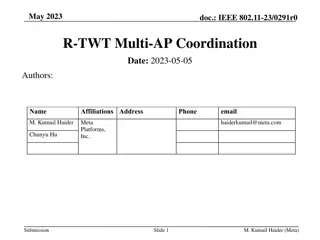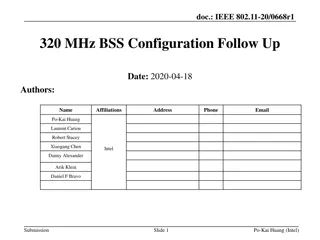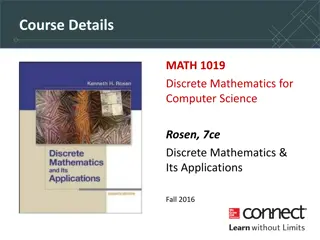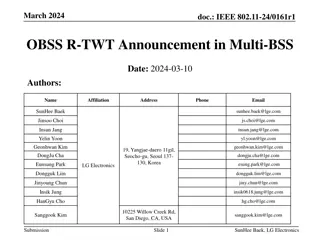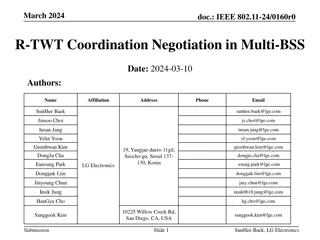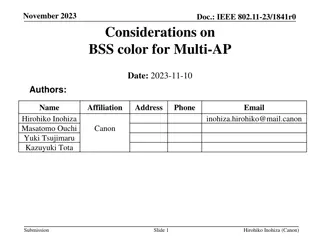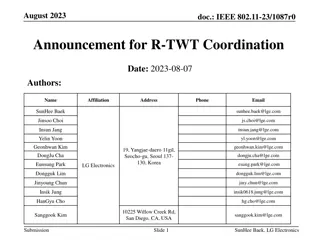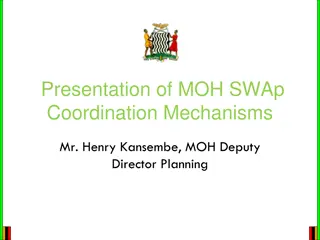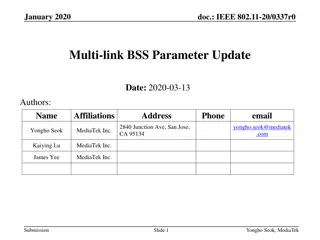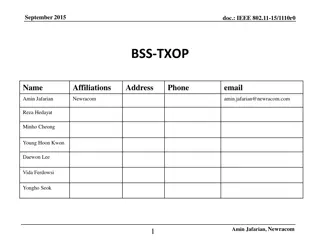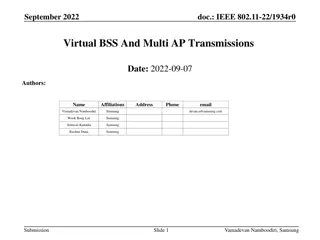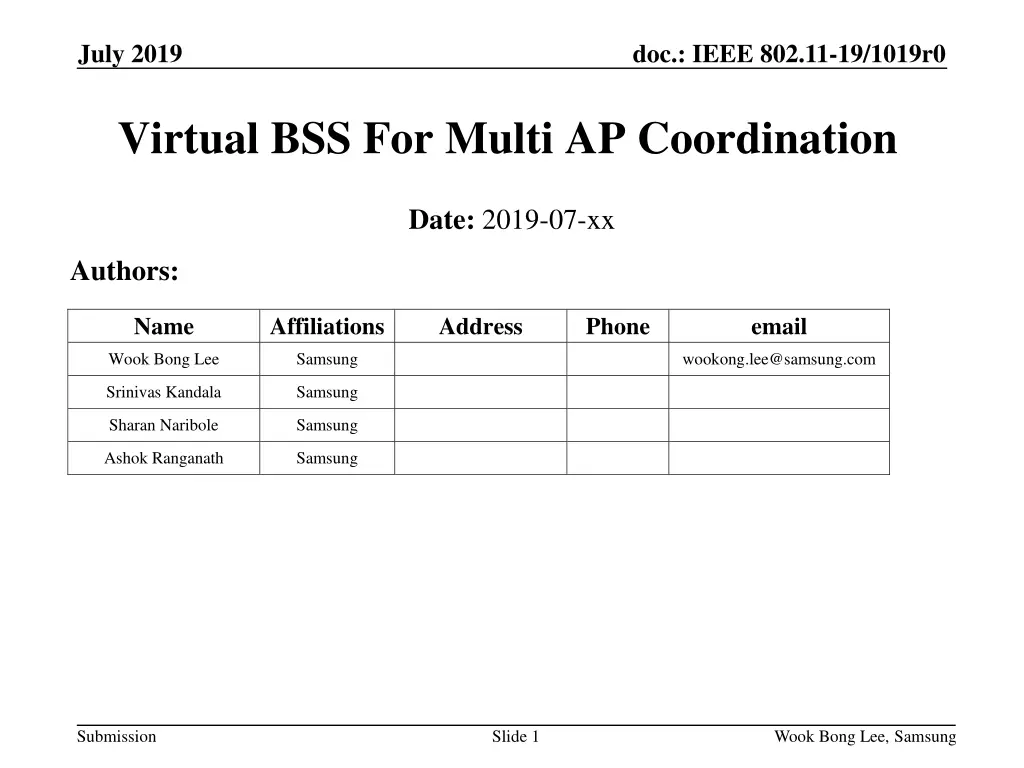
IEEE 802.11-19/1019r0: Virtual BSS for Multi-AP Coordination
Explore the concept of Virtual BSS for efficient multi-AP coordination in IEEE 802.11 networks. Discover how a group of coordinated APs with a multi-AP coordinator enhances network performance and simplifies AP selection for improved link quality. Learn about dynamic AP selection based on link quality metrics for seamless connectivity within the Virtual BSS setup.
Download Presentation

Please find below an Image/Link to download the presentation.
The content on the website is provided AS IS for your information and personal use only. It may not be sold, licensed, or shared on other websites without obtaining consent from the author. If you encounter any issues during the download, it is possible that the publisher has removed the file from their server.
You are allowed to download the files provided on this website for personal or commercial use, subject to the condition that they are used lawfully. All files are the property of their respective owners.
The content on the website is provided AS IS for your information and personal use only. It may not be sold, licensed, or shared on other websites without obtaining consent from the author.
E N D
Presentation Transcript
July 2019 doc.: IEEE 802.11-19/1019r0 Virtual BSS For Multi AP Coordination Date: 2019-07-xx Authors: Name Affiliations Address Phone email Wook Bong Lee Samsung wookong.lee@samsung.com Srinivas Kandala Samsung Sharan Naribole Samsung Ashok Ranganath Samsung Submission Slide 1 Wook Bong Lee, Samsung
July 2019 doc.: IEEE 802.11-19/1019r0 Introduction There are many categories of multi-AP coordination including joint processing, coordinate OFDMA, null forming, coordinated beamforming, AP selection, etc In this contribution, we propose virtual BSS concept Submission Slide 2 Wook Bong Lee, Samsung
July 2019 doc.: IEEE 802.11-19/1019r0 Virtual BSS We define the following concepts Virtual BSS: An infrastructure BSS with a group of coordinated APs. In the coordinated AP group, there is one multi-AP coordinator and one or more member APs Anchor AP(s): selected AP(s) for serving a STA Features of virtual BSS: All member APs share same SSID All member APs share the association / authentication When STA roaming in a virtual BSS, no association/authentication required STA use same AID in the virtual BSS STA will keep a local copy of capabilities of anchor AP and neighboring APs We can also consider same BSSID for all member APs Note that all of the member APs are on the same channel (BSS) Submission Slide 3 Wook Bong Lee, Samsung
July 2019 doc.: IEEE 802.11-19/1019r0 Anchor AP(s) Selection Not all APs in the network will give benefit to a STA. For example, Joint beamforming shows no benefit when pathloss difference between APs is large (e.g. 20dB in below figure) Need to select proper AP(s) to minimize complexity Submission Slide 4 Wook Bong Lee, Samsung
July 2019 doc.: IEEE 802.11-19/1019r0 Dynamic AP selection In a coordinated AP group, STA or AP can dynamically select the anchor AP based on link quality metric (LQM) Examples of possible LQM: Measurement at STA side: RSSI etc Information from member APs: member AP s channel capacity to multi-AP coordinator, member AP s capabilities, number of STAs attached to the member AP etc Options of dynamic AP selection: Option 1: STA driven AP selection AP may send all AP side link quality metric information to the STA STA select its anchor AP in the coordinated AP group based on information provided by member APs and/or its own measurements Option 2: multi-AP coordinator controlled AP selection STA can request anchor AP switching STA broadcast sounding frames Member APs measure the RSSI and forward the information to the multi-AP coordinator Multi-AP coordinator select the anchor AP for a STA Option 3: Combination of option 1 and 2 STA select anchor AP for UL transmission follow option 1 AP decide anchor AP for DL transmission follow option 2 Submission Slide 5 Wook Bong Lee, Samsung
July 2019 doc.: IEEE 802.11-19/1019r0 STA driven AP selection STA dynamically select the anchor AP based on its own measurement When STA selects an anchor AP or switches to a new anchor AP, the STA shall initiate some UL transmission Below figure is an example. Link between APs and coordinator can be in-band or out-band including DS. in-band or out-band ACK in-band DL data Coordinator Beacon 1 Relayed data AP 1 Relayed data ACK Beacon 2 AP 2 STA UL data to the selected anchor AP Submission Slide 6 Wook Bong Lee, Samsung
July 2019 doc.: IEEE 802.11-19/1019r0 Coordinator controlled AP selection STA provide measurement information to the neighboring member APs STA can individually report CSI to the neighboring member APs or STA can broadcast sounding NDP packets to the neighboring member APs. These APs will measure the link quality metric based on the sounding packets Member APs report the link quality metric between itself and the STA to the coordinator Coordinator selects the anchor AP for the STA in-band or out-band in-band ACK ACK DL data Coordinator LQM report AP 1 ACK LQM report Relayed data AP 2 STA Broadcast sounding UL data to the anchor AP Submission Slide 7 Wook Bong Lee, Samsung
July 2019 doc.: IEEE 802.11-19/1019r0 Multiple anchor APs and coordinated transmission STA may have more than one anchor AP in the virtual BSS DL and UL traffic may use different anchor AP Multiple anchor AP may jointly serve one STA Joint transmission can be done using same time and frequency resources or different resources, e.g. in TDM/FDM manner Supporting of multiple anchor APs: In STA driven AP selection scheme, STA need to inform master AP the list of anchor APs of its choice In coordinator controlled AP selection, the coordinator can choose the anchor APs for a STA in DL traffic. Submission Slide 8 Wook Bong Lee, Samsung
July 2019 doc.: IEEE 802.11-19/1019r0 Seamless Operation Sharing association / authentication in the virtual BSS will speed up the handover procedure between member APs STA driven anchor AP selection will make handover seamless Reuse roaming algorithm STA has better knowledge on link quality to neighboring member APs STA can select/update its anchor AP based on its own measurements Load balancing can be done by AP Submission Slide 9 Wook Bong Lee, Samsung
July 2019 doc.: IEEE 802.11-19/1019r0 Transparent Data Reception STA may receive packet from any AP within virtual BSS STA can process all data packet based on anchor AP as if only the AP is transmitting DL PPDU reception is same as single AP PPDU reception Whether data is transmitted/beamformed by multiple AP or single AP is not important for data receive process Coordinated BFed (including null forming) PPDU is same as SU BFed PPDU Coordinated OFDMA PPDU is same as OFDMA PPDU Joint Processed PPDU is same as DL MU-MIMO PPDU Sounding procedure and beamforming feedback procedure may be different from single AP operation: TBD Submission Slide 10 Wook Bong Lee, Samsung
July 2019 doc.: IEEE 802.11-19/1019r0 Conclusion In this contribution, we proposed virtual BSS for multi- AP coordination. In virtual BSS, non-AP STA can perform fast and seamless handover. In virtual BSS, non-AP STA s operation is almost identical to that of single BSS operation while getting benefit from multi-AP coordination. Submission Slide 11 Wook Bong Lee, Samsung
July 2019 doc.: IEEE 802.11-19/1019r0 Reference [1] 11-18/1575r0, Further study on potential features Submission Slide 12 Wook Bong Lee, Samsung


